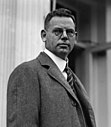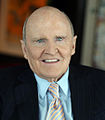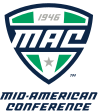University of Massachusetts Amherst
Five Colleges | |
| Endowment | $507 million (2023)[3] |
|---|---|
| Chancellor | Javier Reyes |
| Provost | Tricia Serio[4] |
Academic staff | 1,550 (2023)[5] |
| Students | 31,810 (2023)[6] |
| Undergraduates | 23,936 (2023)[7] |
| Postgraduates | 7,874 (2023)[8] |
| Location | , , United States 42°23′20″N 72°31′40″W / 42.38889°N 72.52778°W |
| Campus | Large suburb, 1,463 acres (5.92 km2) |
| Newspaper | The Massachusetts Daily Collegian |
| Colors | Maroon and white[9] |
| Nickname | Minutemen and Minutewomen[10] |
Sporting affiliations |
|
| Mascot | Sam the Minuteman[11] |
| Website | www |
The University of Massachusetts Amherst (UMass Amherst) is a
With more than 31,000 students, UMASS Amherst is the second largest university in Massachusetts by enrollment after Northeastern University.[12] The university offers academic degrees in 109 undergraduate, 77 master's, and 48 doctoral programs. Programs are coordinated in nine schools and colleges.[13] It is classified among "R1: Doctoral Universities – Very high research activity".[14] According to the National Science Foundation, the university spent $211 million on research and development in 2018.[15][13]
The university's 21 varsity athletic teams compete in
History
Foundation and early years
The university was founded in 1863 under the provisions of the
The original buildings consisted of Old South College, North College, the Chemistry Laboratory, the Boarding House, the Botanic Museum, and the Durfee Plant House.[20]
The fledgling college grew under the leadership of President
The early 20th century saw expansion in enrollment and curriculum. The first female student was admitted in 1875 on a part-time basis and the first full-time female student was admitted in 1892. In 1903, Draper Hall was constructed for the dual purpose of a dining hall and female housing. The first female students graduated with the class of 1905. The first dedicated female dormitory, the Abigail Adams House (on the site of today's Lederle Tower) was built in 1920.[21]
Modern era
By the 1970s, the University continued to grow and gave rise to a shuttle bus service on campus as well as many other architectural additions; this included the Murray D. Lincoln Campus Center complete with a hotel, office space, fine dining restaurant, campus store, and passageway to the parking garage, the W. E. B. Du Bois Library, and the Fine Arts Center.
Over the next two decades, the John W. Lederle Graduate Research Center and the Conte National Polymer Research Center were built and UMass Amherst emerged as a major research facility. The Robsham Memorial Center for Visitors welcomed thousands of guests to campus after its dedication in 1989. For athletic and other large events, the Mullins Center was opened in 1993.
21st century
In 2003,
From World War II to 2023, the imagery on the official seal of the university was nearly identical to the state flag of the Commonwealth of Massachusetts.[25] That image of the seal has been slowly removed starting in 2011, until March, 2023 when a new image of the seal, featuring a profile of the Old Chapel spire, was ratified by the campus.[26]
Organization and administration
Colleges and schools
| College/School | Year founded |
| Stockbridge School of Agriculture | 1870 |
| College of Education | 1907 |
| College of Humanities & Fine Arts | 1915 |
| School of Public Health and Health Sciences | 1937 |
| College of Social and Behavioral Sciences | 1938 |
| Isenberg School of Management | 1947 |
| College of Engineering | 1947 |
| Elaine N. Marieb College of Nursing | 1953 |
College of Natural Sciences |
2009 |
Manning College of Information and Computer Sciences |
2015 |
| School of Public Policy | 2016 |
Since the University of Massachusetts Amherst was founded as the Massachusetts Agricultural College in 1863, 25 individuals have been at the helm of the institution.[27] Originally, the chief executive of UMass Amherst was a president. When UMass Boston was founded in 1963, it was initially reckoned as an off-site department of the Amherst campus and was headed by a chancellor who reported to the president. A 1970 reorganization transferred day-to-day responsibility for UMass Amherst to a chancellor as well, with both chancellors reporting on an equal basis to the president. The title "President of the University of Massachusetts" now refers to the chief executive of the entire five-campus University of Massachusetts system.
The current Chancellor of the Amherst campus is Javier Reyes.[28] The Chancellor resides in Hillside, the campus residence for chancellors.[29] Reyes is the first person of Hispanic descent to serve as Chancellor of the university.[28]
There are approximately 1,300 full-time faculty at the university.
Academics
Rankings and reputation
Forbes[30] | 126 | |
|---|---|---|
| U.S. News & World Report[31] | 67 | |
| Washington Monthly[32] | 90 | |
| WSJ / College Pulse[33] | 141 | |
| Global | ||
| ARWU[34] | 151–200 | |
| QS[35] | 245 | |
| THE[36] | 123 | |
| U.S. News & World Report[37] | 160 | |
U.S. News & World Report's 2021 edition of America's Best Colleges ranked UMass Amherst tied for 66th on their list of "Best National Universities", and tied for 26th among 141 public universities in the U.S.[38] UMass Amherst is accredited by the New England Commission of Higher Education.[39]
Commonwealth Honors College
Commonwealth Honors College at UMass provides students the opportunity to intensify their UMass academic curriculum. Membership in the honors college is not required to graduate from the University with designations such as
Five College Consortium
UMass Amherst is part of the Five Colleges Consortium, which allows its students to attend classes, borrow books, work with professors, etc., at four other Pioneer Valley institutions: Amherst, Hampshire, Mount Holyoke, and Smith Colleges.
UMass Amherst holds the license for
Community service
The Community Engagement Program (CEP) offers courses that combine classroom learning and community service. Co-curricular service programs include the Alternative Spring Break, Engineers without Borders, the Legal Studies Civil Rights Clinical Project, the Medical Reserve Corps, Alpha Phi Omega, the Red Cross Club, the Rotaract Club, UCAN Volunteer, and the Veterans and Service Members Association (VSMA).
The White House has named UMass Amherst to the President's Higher Education Community Service Honor Roll for four consecutive years, in recognition of its commitment to volunteering, service learning, and civic engagement.[42] They have also been named a "Community-Engaged University" by the Carnegie Foundation for the Advancement of Teaching.[43]
Research
| Race and ethnicity[44] | Total | ||
|---|---|---|---|
| White | 61% | ||
| Asian | 11% | ||
| Hispanic | 8% | ||
| Foreign national | 7% | ||
| Other[a] | 7% | ||
| Black | 5% | ||
| Economic diversity | |||
| Low-income[b] | 20% | ||
| Affluent[c] | 80% | ||
UMass research activities totaled more than $200 million in fiscal year 2014 ($257,407,928 in today's money).
A team of scientists at UMass led by Vincent Rotello has developed a molecular nose that can detect and identify various proteins. The research appeared in the May 2007 issue of Nature Nanotechnology, and the team is currently focusing on sensors, which will detect malformed proteins made by cancer cells.[46] Also, UMass Amherst scientists Richard Farris, Todd Emrick, and Bryan Coughlin led a research team that developed a synthetic polymer that does not burn. This polymer is a building block of plastic, and the new flame-retardant plastic will not need to have flame-retarding chemicals added to its composition. These chemicals have recently been found in many different areas from homes and offices to fish, and there are environmental and health concerns regarding the additives. The newly developed polymers would not require the addition of potentially hazardous chemicals.[47]
Admissions and enrollment
In 2012, the university reported that applications to the school had more than doubled since the Fall of 2003 and increased more than 80% since 2005.[48][49]
The incoming Class of 2022 had an average high school
Campus
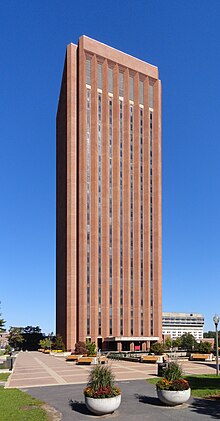
The University's campus is situated on 1,450 acres of historically
The
The Science and Engineering Library is the other library on campus and is located in the Lederle Graduate Research Center Lowrise. UMass is also home to the DEFA Film Library, the only archive and study collection of East German films outside of Europe, and the Shirley Graham Du Bois Library in the New Africa House. The university has several buildings (constructed in the 1960s and 1970s) of importance in the modernist style, including the
The campus facilities underwent extensive renovations during the late 1990s. New and newly renovated facilities include student apartment complexes, the Hampshire Dining Commons, a library Learning Commons, a School of Management, an Integrated Science Building, a Nursing Building, a Studio Arts Building, the Combined Heat and Power (CHP) generation facility, a track facility, and a Recreation Center. Newly completed construction projects on campus include the new Campus Police Station, the George N. Parks Minuteman Marching Band Building, the Life Sciences Laboratories, and the Integrated Learning Center.[58]
Residential life
Residential Life at the University of Massachusetts Amherst is one of the largest on-campus housing systems in the United States. Over 14,000 students live in 52 residence halls, while families, staff, and graduate students live in 345 units in two apartment complexes (North Village and Lincoln). The fifty-two residence halls and four undergraduate apartment buildings are grouped into seven separate and very different residential areas: Central, Northeast, Orchard Hill, Southwest, Sylvan, North Apartments, and the Commonwealth Honors College Residential Community (CHCRC).
Located in the central corridor of campus, the Honors Community houses undergraduate members of Commonwealth Honors College.[59]
Major campus expansion

The University of Massachusetts Amherst campus embarked on a 10-year, $1 billion ($1,613,107,822 in today's money) capital improvement program in 2004, setting the stage for re-visioning the campus's future.[60][61][62] This includes construction of $156 million New Science Laboratory Building, $30 million Champions Basketball Center, an $85 million academic building, and $30 million in renovations to the football stadium.[63]
In early 2016, the construction of a new electrical substation located near Tillson Farm was completed.[64] The purpose of the substation is to supply electricity to the university more efficiently and reliably, with estimated savings of $1 million per year ($1,269,551 in today's money).[64] The project was created in partnership with the utilities company Eversource, and cost approximately $26 million ($33,008,319 in today's money).[64]
In April 2017, the University of Massachusetts Amherst officially opened its new Design Building. Previously estimated at $50 million (62,150,421 in today's money) the 87,000 square feet (8,100 m2) facility is the most advanced CLT building in the United States and the largest modern wood building in the northeastern United States.[65][66]
Mount Ida Campus of UMass Amherst
Campus safety
Campus safety features include controlled dormitory access, emergency telephones, lighted sidewalks, and 24-hour campus police patrols on feet and by vehicle.[68]
Riots occurred after the Boston Red Sox lost the 1986 World Series and won in 2004 and 2007, after the Red Sox were eliminated in the 2003 and 2008 playoffs, after UMass' football team lost in the Division I-AA football championship game in 2006 and after the Patriots first Super Bowl victory over St. Louis in Super Bowl XXXVI. The majority of these riots have been non-violent on the side of the students, except for the 1986 riot in which an argument between hundreds of students intensified into racial altercations where a black student was attacked and beaten to unconsciousness by fifteen to twenty white students according to archives from The Republican. In the wake of these events, students have worked to have open dialogues with the administration and police department about campus safety, the right to gather, the police force, and better methods of crowd control.[69]
Iranian student admissions controversy
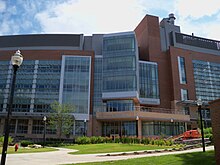
UMass Amherst issued an announcement in early 2015 stating, "The University has determined that it will no longer admit Iranian national students to specific programs in the College of Engineering (i.e., Chemical Engineering, Electrical & Computer Engineering, Mechanical & Industrial Engineering) and in the College of Natural Sciences (i.e., Physics, Chemistry, Microbiology, and Polymer Science & Engineering) effective February 1, 2015."[70] The University claims that this announcement was posted because a graduate student entered Iran for a project and was later denied a visa. This event along with urging from legal advisers contributed to the belief that such incidents inhibited their ability to give Iranian students a "full program of education and research for Iranian students" and thus justified changing their admissions policies. The ensuing criticism on and off campus, as well as wide media publicity, changed the minds of school officials. As a result, UMass made a statement on February 18 committing to once again allowing Iranian students to apply to the aforementioned graduate programs.[71] On the same day, an official in the U.S. Department of State stated in an interview that: "U.S. laws and regulations do not prevent Iranian people from traveling to the United States or studying in engineering program of any U.S. academic institutions."[72] UMass Amherst replaced the ban with a policy aimed at designing specific curricula for admitted Iranian nationals based on their needs. While less controversial, this policy has still generated backlash, with one student saying, "This university that's supposed to be so open-minded forcing him to sign a document saying he won't go home and build a bomb or something is just really disappointing to see."[73]
Student life
Arts on campus
The UMass Amherst campus offers a variety of artistic venues, both performance and visual art. The most prominent is the Fine Arts Center (FAC) built in 1975. The FAC brings theater, music, and dance performances to campus throughout the year into its performance spaces (Concert Hall, Bezanson Recital Hall, and Bowker Auditorium). These include several performance series: Jazz in July Summer Music Program, The Asian Arts & Culture Program, Center Series, and Magic Triangle Series presenting music, dance, and theater performances, cultural arts events, films, talks, workshops, masterclasses, and special family events. University Museum of Contemporary Art in the FAC has a permanent contemporary art collection of about 2,600 works and hosts numerous visual arts exhibitions each year as well as workshops, masterclasses, and artist residencies.[74]
The 9,000-seat Mullins Center, the multi-purpose arena of UMass Amherst hosts a wide variety of performances including speakers, rock concerts, and Broadway shows. In addition, the Music, Dance, and Theater Departments, the Renaissance Center, and multiple student groups dedicated to the arts provide an eclectic menu of performances throughout the year.
The Interdepartmental Program for Film Studies has been organizing the Massachusetts Multicultural Film Festival on campus since 1991.[75]
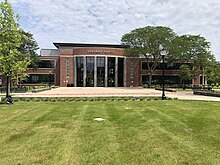
Groups and activities
UMass Amherst has a history of protest and activism among the undergraduate and graduate population[76] and is home to over 200 registered student organizations (RSOs).
Student Government Association
The
UMass permaculture
UMass permaculture is one of the first university permaculture initiatives in the nation and transforms marginalized landscapes on the campus into diverse, educational, low-maintenance, and edible gardens.[78] Rather than tilling the soil, a more sustainable landscaping method known as sheet mulching is employed. In November 2010, "about a quarter of a million pounds of organic matter was moved by hand", using all student and community volunteer labor and no fossil fuels on-site.[79] The process took about two weeks to complete. Now, the Franklin Permaculture Garden includes a diverse mixture of "vegetables, fruit trees, berry bushes, culinary herbs, and a lot of flowers that will attract beneficial insects."[79]
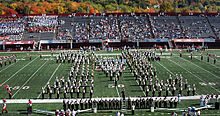
Minuteman Marching Band
UMass Amherst has the largest marching band in New England. The Minuteman Marching Band consists of over 390 members and regularly plays at football games. The band also performs in various other places and events like the
Fraternities and sororities
Fraternities, sororities, and honor societies have been present on the campus almost since inception, with its first fraternity, the Latin letter-named Q.T.V. emerging in 1869, and the first sorority, Delta Phi Gamma (local) in 1916.[d] Approximately 1,500 students are active members each academic year.[80][81][82]
Several fraternities had houses on North Pleasant Street until 2007 when several lots owned by Alpha Tau Gamma were sold to the University for $2,500,000 ($3,673,568 in today's money).[83] Alpha Tau Gamma, a local fraternity associated with the Stockbridge School of Agriculture, then donated $500,001 to endow the salary for the Director of the Stockbridge School.[83]
Criticism of sexual and alcohol abuse, especially because of the role that Greek Life Organizations play at the university, has appeared repeatedly in Boston's and national news.[84][85] Some students have called for changes in policy.[86]
Today, most chapters are affiliated with national societies but are largely self-governing, within four councils.
| Interfraternity Council (IFC) | National Pan-Hellenic Council | Multicultural Greek Council | National Pan-Hellenic Council | Honor societies, service, and veterans' organizations |
|---|---|---|---|---|
Media
The Massachusetts Daily Collegian
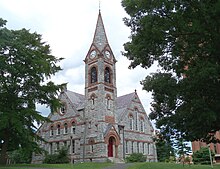
The Massachusetts Daily Collegian, the official newspaper of UMass Amherst, is published Monday through Thursday during the calendar semester. The Collegian is a non-profit student-run organization that receives no funding from the University or student fees. The Collegian operates entirely on advertising revenues. Founded in 1890, the paper began as Aggie Life, became the College Signal in 1901, the Weekly Collegian in 1914, and the Tri-Weekly Collegian in 1956. Published daily since 1967, the Collegian has been broadsheet since January 1994.
WMUA 91.1 FM
The student-operated radio station,
WSYL-FM
There was a student-run, extremely-low-power FM radio station that used the self-assigned identifier "WSYL-FM" (With Songs You Like) which operated in the basement of Cashin from the mid-1970s through the 1980s.[87]
Athletics
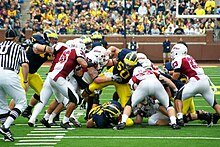
UMass is a member of Division I of the National Collegiate Athletic Association (NCAA). The university is a member of the Atlantic 10 Conference while playing ice hockey in the Hockey East Association. The football team joined the Mid-American Conference (MAC), to play at Football Bowl Subdivision (FBS; the sport's highest level) with games played at Gillette Stadium in 2012.[88] In March 2014, the MAC and UMass announced an agreement for the Minutemen football team to leave the conference after the 2015 season due to UMass declining an offer to become a full member of the conference. In the agreement between the MAC and the university, there was a contractual clause that had UMass playing in the MAC as a football-only member for two more seasons if UMass declined a full membership offer. UMass announced that it would look for a "more suitable conference" for the team.[89] UMass was unable to find a "suitable conference" for nearly a decade, remaining a full A-10 member and becoming an FBS independent, but during the early-2020s conference realignment entered into membership discussions with both the MAC and Conference USA.[90] On February 29, 2024, it was announced that UMass would join the MAC as a full member, including football, in July 2025.[91]
UMass originally was known as the Aggies,
The UMass Amherst Department of Athletics currently sponsors men's intercollegiate baseball, basketball, cross country, ice hockey, football, lacrosse, soccer, swimming, and indoor and outdoor track & field. They also sponsor women's intercollegiate basketball, softball, cross country, rowing, lacrosse, soccer, swimming, field hockey, indoor and outdoor track & field, and tennis. Club sports offered which are not also offered at the varsity level are men's wrestling, men's rowing, men's tennis, women's ice hockey, men's and women's rugby, men's and women's bicycle racing, and men's and women's fencing. Men's and women's downhill skiing have been re-certified as club sports following the April 2, 2009 announcement of their discontinuation as varsity sports.[93]
Notable alumni
There are 243,628 University of Massachusetts Amherst alumni worldwide.[94] Notable UMass Amherst alumni include Greg Landry, Jeff Corwin, Buffy Sainte-Marie, Taj Mahal, Bill Paxton, William Monahan, Kenneth Feinberg, Bill Cosby,[95] Natalie Cole,[96] Julius "Dr. J" Erving, Rick Pitino, Bill Pullman, Betty Shabazz, Briana Scurry, Jack Welch, John F. Smith Jr., Jean Worthley, Jeff Reardon, Mike Flanagan, Lawrence Mestel, and Richard Gere.
- Notable alumni
-
Hall of Famebasketball player
-
LTG Jody Daniels (MSc 1993, PhD 1997, Hon DSc 2019), 34th Chief of Army Reserve
-
Zhou Qifeng, 13th President of Peking University
-
Bill Cosby, Stand-up comedian and actor
-
Jack Welch (BSc 1957, Hon DSc 1982), Former Chairman and CEO of General Electric
-
Anshuman Jain (MBA 1985), Former co-CEO and co-Chairman of Deutsche Bank
-
Russell Hulse (PhD 1975), Nobel Prize in Physics
-
Steven Sinofsky, Former President of Windows at Microsoft
-
Betty Shabazz, Civil rights advocate
-
Richard Gere, Film actor and producer


